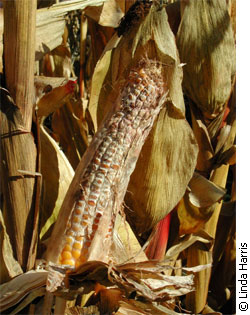|
Healing
the ear:
investigating corn resistance
to a fatal fungus
By Carol Crabbe
OTTAWA —
Linda Harris has always been
interested in learning "how life works." As
a result, she has been doing scientific research since
the late-'70s.
 |
| Gibberella ear rot, caused by
the fungus Fusarium graminearum |
Her first published work was a paper on
the feeding habits of the white pine weevil –
research she conducted while an undergraduate student
at Simon Fraser University in British Columbia. From
there, she's worked on various subjects within genetics
and molecular biology
Now, Harris has moved east to the Central
Experimental Farm to pursue her interest in plant-pathogen
interaction and do reseach onplant disease caused by
the fungus Fusarium graminearum.
Fatal fungus
This fungus, usually called Fusarium, causes
cereal plants like wheat, barley and corn to go mouldy
and dangerous for humans and animals to eat. Harris
is working with other researchers at the Farm's Eastern
Cereal and Oilseed Research Centre to find out more
about the disease and its effect on corn.
Fusarium causes an increase in deoxynivalenol
(DON) – a toxin that is dangerous for humans to
consume. DON is also known as the vomit toxin, because
it causes animals to throw up. Other toxins can also
cause abortions in animals.
Fusarium enters corn through the silk tassels
on the ear or directly through "wounds" or
holes made on the corn's surface by insects and birds.
According to Harris, this fungus does well in temperate
climates, which is why it is so prominent in parts of
Canada. Fusarium also needs a humid environment
to develop and finds a perfect atmosphere in the parts
of Canada where corn is grown.
Corn also has limited resistance to Fusarium so
that large yields of the crop can become useless for
human and animal consumption, and cost farmers millions
of dollars in losses.
Finding out about Fusarium
Harris studies the genes of the corn plant and the
proteins these genes produce to find out what happens
when the fungus attacks a plant.
| 'Some genes are
"turned on" when Fusarium attacks
and some are "turned off."' |
To do this, Harris and her fellow researchers first
grow Fusarium in V-8 juice. The V-8 juice has
nutrients the fungus needs to grow, Harris says, so
its an ideal environment The next step is to infect
ears of corn with the fungus and see what proteins are
produced in the corn, and what genes produce these proteins.
This is the basis of the proteomic and genomic study.
The corn used for these experiments is grown on the
Farm. It is important to find out about the genes in
the plant, Harris says, because in each ear of corn,
there are two kinds: genes that are "turned on"
when Fusarium attacks and ones that are "turned
off."
Pictures of genes
Microarrays are like photos of genes, and are used
to find out which ones work harder when the disease
attacks, and which ones work less. If a gene is "turned
on" in reaction to the fungus, it produces more
of a particular protein, and if it is "turned off"
it produces less of that protein.
 |
Picture of Genes: subsample
of a microarray comparing the gene expression
levels of thousands of maize genes responding
to Fusarium infection.
|
The research seems pretty basic, but Harris says this
information is essential because the genes in the plant
can be catalogued from this process.With this information,
links can be made between resistance, genes and proteins
in corn.
Further research can then be done to isolate the specific
genes that cause resistance, and these genes can be
reproduced to make corn plants more able to withstand
the disease.
What's next?
Predictably, the groups most interested in this research
are the Ontario Corn Producers Association and Ontario
Pork Producers, who are funding her work along with
a number of smaller groups. According to Harris, most
of the corn produced in the eastern part of Canada is
fed to pigs.
Fusarium research is wide ranging in Canada
, some researchers focus on the fungus itself –
which has already been genetically sequenced –
and others, like Harris, focus on the plants it attacks.Harris
says most of the previous research has been done using
wheat, but very little has been done with corn.
With her research, Harris is in some way learning
"how life works" and in the process, helping
to heal the corn industry. One ear at a time.
|